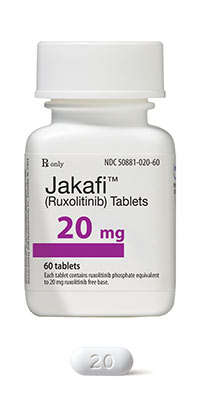Product
Jakafi
Approval Date
November 16, 2011
Release Date
Fourth quarter 2011
Company
Incyte Corp.
Class
Kinase inhibitor
Indication
Treatment of intermediate or high-risk myelofibrosis, including primary myelofibrosis, post-polycythemia vera myelofibrosis and post-essential thrombocythemia myelofibrosis.
Active Ingredient
Ruxolitinib
Agency Roster
Harrison & Star (professional)
IMC2 (digital)
Marketing Strategy/Execution
Incyte’s marketing strategy for Jakafi includes a mix of direct and non-personal selling tactics designed, first and foremost, to increase awareness and education. That will take a while, because the prescriber base is dispersed and is likely to have only a handful of myelofibrosis patients each. By and large, clinicians are not too familiar with Jakafi ahead of the launch. The firm has a field force numbering 60 territory managers in place to cover about 6,500 treating physicians — primarily specialists in hem/onc. Each rep averages 18 years of experience, including 11 in hem/onc, and many have established relationships with providers. HCP conference activity and non-personal, multichannel promotion are also being deployed to drive awareness and use. The firm is charging $7,000 a month ($84,000 a year) for the new pill.
Physician Outlook
Jafaki is an enormous breakthrough in targeted therapy, as it is the first in its class of Janus Kinase (JAK) inhibitors approved for any indication. The JAK family of signaling molecules has been implicated in various cancer cell functions, most recently being associated with the spread of cancers. Furthermore, it is currently the only drug approved for intermediate and high-risk MF. This patient group represents 80 to 90 percent of MF patients, including primary MF, post-polycythemia vera and post-essential thrombocythemia MF. The partnering of Jakafi developer the Incyte Corporation with Novartis Pharmaceutical for the development and marketing of Jakafi outside of the USA, will be a strong driver in having hematologists and oncologists embrace this new drug. The approval of Jakafi not only adds a new weapon in the arsenal against hematologic cancers, but may herald exciting future developments in cancer therapeutics, as we gain experience with it and the other JAK inhibitors that may soon come to market..
—Rishard Salie, PhD, project manager, research & consulting, GfK HealthCare, Dec. 2011
Also in the Pipeline (courtesy of Adis R&D Insight)
Drug: Actimid
Manufacturer: Celgene Corp.
Indication: Myelofibrosis
Active Ingredient: Pomalidomide
Phase: III
Source: Wolters Kluwer Pharma Solutions
Recent MM&M Coverage
No ‘pent-up demand’ for cancer med Jakafi, Incyte says
Pharmacology
Ruxolitinib inhibits Janus Associated Kinases (JAKs) JAK1 and JAK2, which mediate the signaling of a number of cytokines and growth factors that are important for hematopoiesis and immune function.
Clinical Trials
The efficacy of Jakafi was evaluated in two clinical trials in patients with myelofibrosis. The starting dose was based on platelet count. Patients with a platelet count between 100–200X109/L were started on Jakafi 15mg twice daily, while patients with a platelet count >200X109/L were started on Jakafi 20mg twice daily. Doses were subsequently individualized based on tolerability and efficacy; maximum doses were 20mg twice daily if platelet counts were between 100 to ≤125X109/L, 10mg twice daily if platelet counts were between 75 to ≤100X109/L, and 5mg twice daily if platelet counts were between 50 to ≤75X109/L.
At primary endpoint, a significantly larger proportion of patients in the Jakafi group achieved a 35% or greater reduction in spleen volume from baseline in both studies (as compared to placebo in Study 1, and as compared to best available therapy in Study 2). A similar proportion of patients in the Jakafi group achieved a ≥50% reduction in palpable spleen length.
Adverse Reactions
Thrombocytopenia, anemia, neutropenia, bruising, dizziness, headache, UTIs, weight gain, flatulence, herpes zoster.
Adults
Doses may be given by NG tube if unable to swallow tabs. Platelets >200X109/L: initially 20mg twice daily. Platelets 100–200X109/L: initially 15mg twice daily. May increase doses by 5mg twice daily to a max of 25mg twice daily; do not increase during the first 4wks of therapy and not more frequently than every 2wks. Discontinue treatment after 6mos if no reduction in spleen size or symptom improvement. Interrupt treatment if platelets <50X109/L. May restart or increase after recovery of platelets (see literature for max allowable restarting doses). Consider dose reductions if platelets decrease but remain >50X109/L (see literature). Concomitant strong CYP3A4 inhibitors: initially 10mg twice daily if platelets ≥100X109/L; if platelets <100X109/L: avoid. Moderate or severe renal impairment (CrCl 15–59mL/min) and platelets between 100–150X109/L: initially 10mg twice daily.
Children
Not established.
Precautions
Monitor for thrombocytopenia, anemia, neutropenia; withhold or reduce dose if occur. Obtain CBC and platelets before initiating therapy, every 2–4 weeks until doses are stabilized, and then as clinically indicated. Risk of serious bacterial, mycobacterial, fungal, and viral infections; evaluate and treat if signs/symptoms occur. Confirm resolution of active infections before starting. Renal or hepatic impairment. Pregnancy (Cat. C). Nursing mothers: not recommended.








